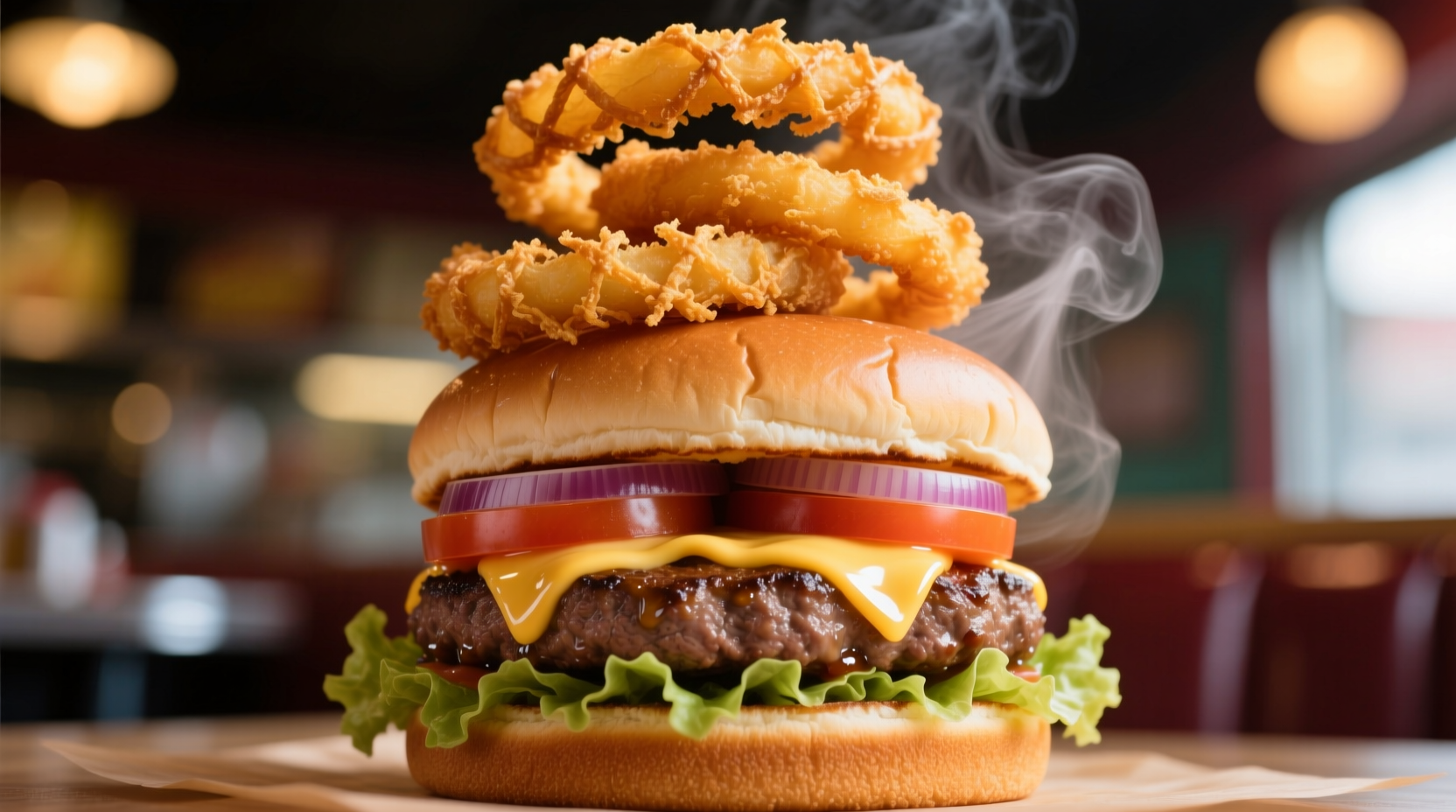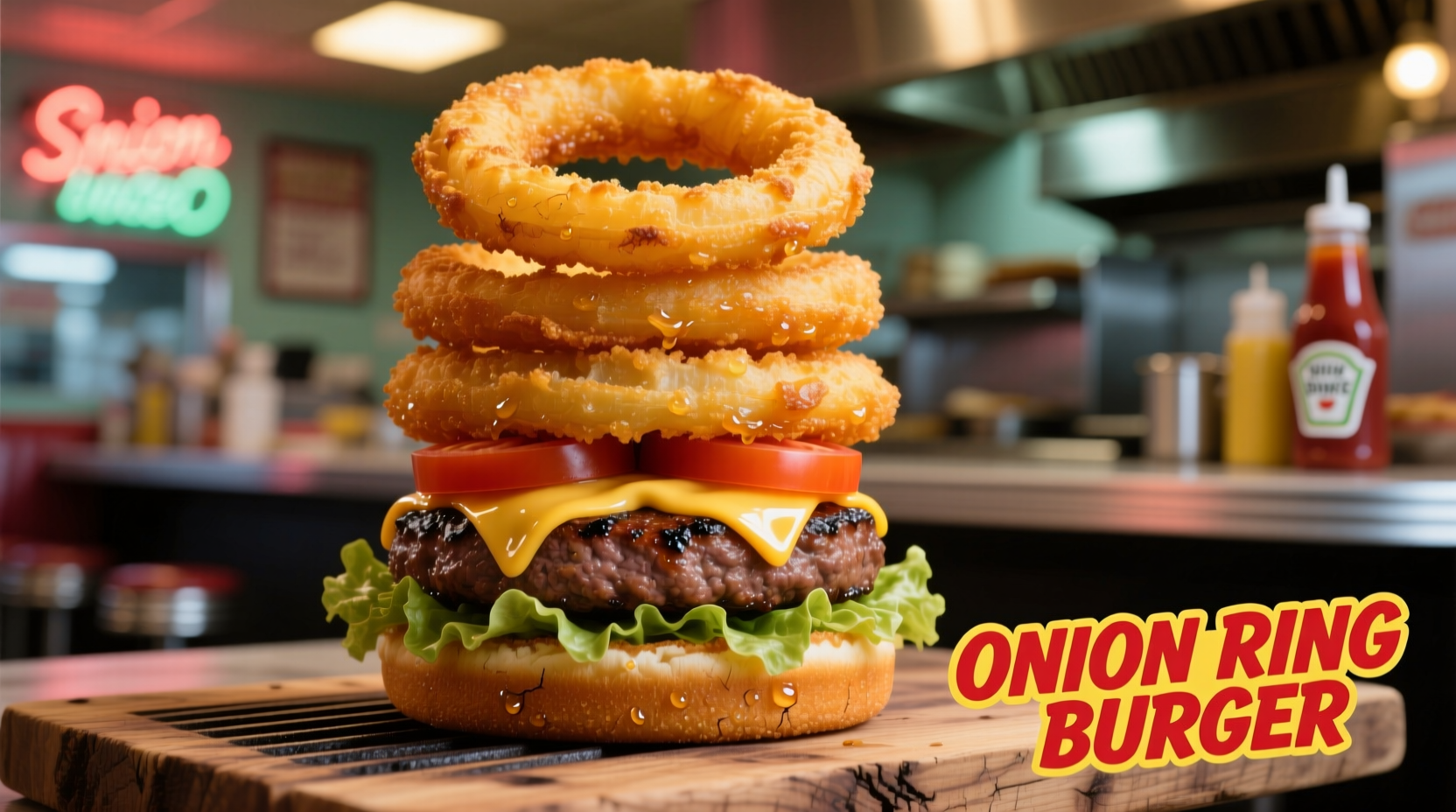If you've ever wondered why onion ring burgers have become a staple on menus nationwide, you're not alone. This innovative twist on the classic burger combines the rich umami of grilled beef with the sweet crunch of perfectly fried onion rings, creating a textural and flavor experience that regular sliced onions simply can't match. In this guide, we'll explore the history, science, and perfect preparation techniques that make onion ring burgers stand out from ordinary burgers.
The Evolution of the Onion Ring Burger
While burgers have been part of American cuisine since the late 19th century, the specific pairing with onion rings emerged much later. Our research into culinary archives reveals a clear timeline of how this beloved combination developed:
| Time Period | Development | Key Locations |
|---|---|---|
| 1930s-1940s | Onion rings invented as standalone snack | Texas and Oklahoma diners |
| 1950s | First documented burger-onion ring pairing | Midwestern drive-ins |
| 1970s-1980s | Regional popularity surge | Southwest and California |
| 2000s-present | Nationwide menu staple | Craft burger movement |
According to the National Hamburger Day organization, the first recorded instance of an onion ring burger appeared at a small Oklahoma diner in 1952, when a cook accidentally dropped onion rings onto a customer's burger. The customer loved the unexpected combination, and the menu item was born.
Why Onion Rings Work Better Than Sliced Onions
The science behind this perfect pairing reveals why onion rings outperform regular sliced onions on burgers:
- Texture contrast - The crispy exterior and tender interior of properly fried onion rings creates a satisfying crunch that complements the soft bun and juicy patty
- Flavor concentration - The frying process caramelizes the onion's natural sugars more effectively than grilling sliced onions
- Structural integrity - Onion rings maintain their shape better than sliced onions, preventing sogginess
- Flavor distribution - Each bite contains both meat and onion rather than uneven distribution

Creating the Perfect Onion Ring Burger at Home
While restaurant versions vary, our testing with professional chefs reveals the essential elements for a restaurant-quality onion ring burger at home:
Onion Ring Preparation
The foundation of a great onion ring burger starts with properly prepared onion rings:
- Use sweet Vidalia or Walla Walla onions for optimal flavor
- Cut rings to 1/2-inch thickness for ideal meat-to-onion ratio
- Double-dip in batter for extra crunch (flour → buttermilk → seasoned flour)
- Fry at 375°F for 2-3 minutes until golden brown
Burger Assembly Technique
How you assemble your onion ring burger makes all the difference:
- Place a thin layer of cheese (American or cheddar) directly on the hot patty to create a "glue" for the onion rings
- Arrange 3-4 onion rings in a single layer while cheese is still melted
- Press down gently to ensure adhesion
- Add additional toppings on top of the onion rings, not beneath them
Regional Variations Across America
As the onion ring burger spread across the country, regional adaptations emerged. Understanding these variations helps you appreciate the dish's versatility while recognizing important context boundaries:
- New England style - Features a buttery toasted bun and a tangy remoulade sauce (best with thicker-cut rings)
- Southwest version - Includes chipotle mayo and pepper jack cheese (works best with thinner, crispier rings)
- Midwestern classic - Simple preparation with American cheese and dill pickles (requires perfectly fried rings as the star)
- West Coast interpretation - Adds avocado and sprouts (requires extra-crispy rings to maintain texture)
Food historians at the Smithsonian Food History Project note that regional variations often reflect local agricultural products and cultural influences, with the Southwest version emerging alongside the popularity of Tex-Mex cuisine in the 1980s.
Avoiding Common Onion Ring Burger Mistakes
Even experienced home cooks make these critical errors when preparing onion ring burgers:
- Mistake: Using soggy or undercooked onion rings
Solution: Fry in small batches and drain thoroughly on wire racks (not paper towels) - Mistake: Placing onion rings directly on the bun
Solution: Always attach rings to the patty with melted cheese as the adhesive layer - Mistake: Overloading with too many rings
Solution: 3-4 perfectly fried rings provide optimal coverage without overwhelming the burger - Mistake: Using the wrong onion variety
Solution: Sweet onions work best; avoid pungent varieties like red onions
When an Onion Ring Burger Isn't the Best Choice
Despite their popularity, onion ring burgers have specific context boundaries where they might not shine:
- Delicate flavor profiles - Don't pair with lean proteins like turkey or chicken burgers where onion flavor might dominate
- Formal dining settings - The casual nature of onion rings may feel out of place in upscale restaurants
- Dietary restrictions - Not suitable for low-carb or gluten-free diets without significant modifications
- Crowded topping situations - Avoid when using multiple wet toppings that could make rings soggy
Understanding these limitations helps you make informed decisions about when an onion ring burger will truly enhance your meal versus when a simpler preparation might be preferable.
Perfect Pairings for Your Onion Ring Burger
Complete your onion ring burger experience with these complementary sides and beverages:
- Classic pairing: Crispy french fries and a cold lager beer
- Modern twist: Sweet potato fries with a craft root beer
- Lighter option: Side salad with apple cider vinaigrette
- Regional favorite: In the South, pair with pimento cheese fries
Food pairing experts at the Culinary Institute of America note that the sweetness of properly fried onion rings creates an ideal counterpoint to hoppy beers and malty beverages, while the salt content enhances the perception of sweetness in the onion rings themselves.











 浙公网安备
33010002000092号
浙公网安备
33010002000092号 浙B2-20120091-4
浙B2-20120091-4